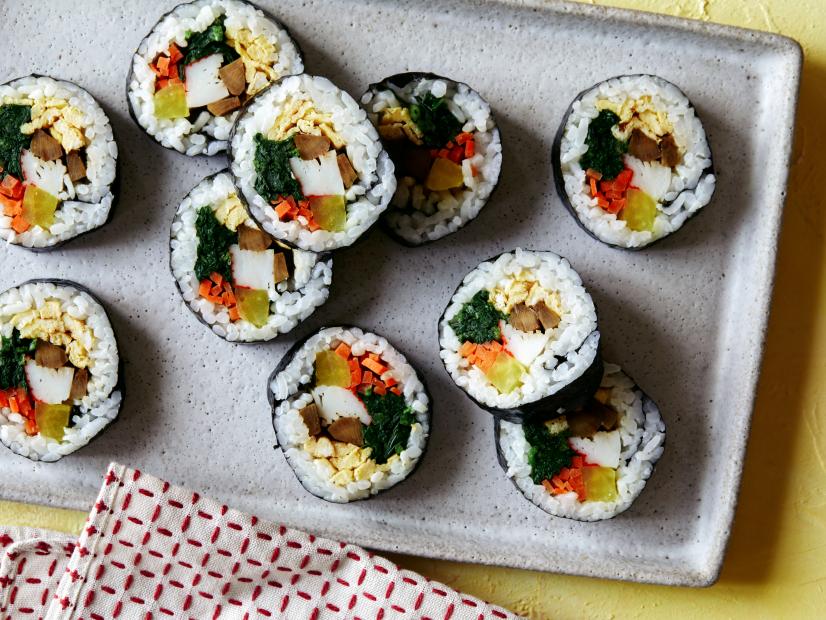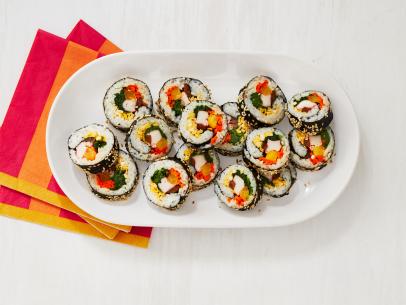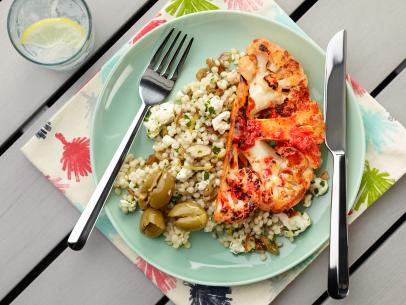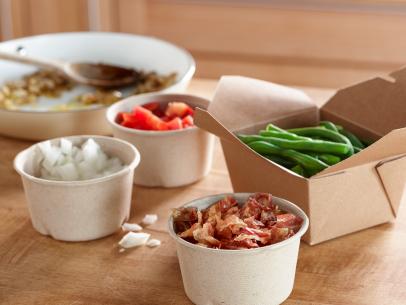
Kimbap
- Level: Intermediate
- Total: 45 min
- Active: 30 min
- Yield: 4 rolls
-
- Nutritional Analysis
- Per Serving
- Calories
- 451
- Total Fat
- 14 grams
- Saturated Fat
- 2 grams
- Cholesterol
- 110 milligrams
- Sodium
- 1073 milligrams
- Carbohydrates
- 65 grams
- Dietary Fiber
- 3 grams
- Sugar
- 7 grams
- Protein
- 16 grams
- Level: Intermediate
- Total: 45 min
- Active: 30 min
- Yield: 4 rolls
-
- Nutritional Analysis
- Per Serving
- Calories
- 451
- Total Fat
- 14 grams
- Saturated Fat
- 2 grams
- Cholesterol
- 110 milligrams
- Sodium
- 1073 milligrams
- Carbohydrates
- 65 grams
- Dietary Fiber
- 3 grams
- Sugar
- 7 grams
- Protein
- 16 grams
Ingredients
Egg Filling:
Spinach Filling:
Carrot Filling:
Rolls:
Directions
Special equipment:
a bamboo sushi mat- For the egg filling: Lightly beat the eggs and a pinch of salt in a medium bowl.
- Heat the oil in large nonstick pan over medium-high heat. Pour in the eggs and swirl the pan until the egg covers the entire surface area. Cook until set on the bottom, about 1 minute. Flip carefully to keep it in one piece and cook 1 minute more. Slide onto a plate or cutting board to cool, then fold the egg crepe in half and fold once more. Cut into julienne strips and set aside. Reserve the pan for the carrot filling.
- For the spinach filling: Bring a pot of water to a boil and prepare an ice water bath. Add the spinach to the boiling water and blanch until it turns bright green, about 30 seconds. Transfer the spinach to the ice bath and let it sit for 5 minutes, then remove and squeeze it dry. Place in a medium bowl, add the sesame oil and season with salt. Mix well and set aside.
- For the carrot filling: Wipe the egg pan clean with a dry paper towel, add the sesame oil and heat over medium-high heat. Cook the carrots until just tender and soft, 2 to 3 minutes. Season with salt. Set aside.
- For the rolls: Prepare a small bowl of water on the side both to help prevent the rice from sticking to your hands and for sealing the kimbap at the end.
- Add the rice, sesame oil and 1/4 teaspoon salt to a large bowl and mix until combined. The rice should be cool enough to handle. If not, let cool for 5 minutes.
- Lay a sheet of gim rough-side up (smooth/shiny-side down) on a bamboo sushi mat with one of the shorter sides closest to you. Spread 3/4 cup of the rice mixture (about the size of a baseball) across the entire sheet in an even layer, leaving 1/4 inch of gim on the bottom and 1/2 inch on the top empty. Make sure the rice is evenly distributed and that no spot is empty.
- Spread one-quarter of the egg, spinach and carrot filling horizontally in rows in the middle of the rice, covering only about a third of the rice. Leaving the rest of rice completely empty, continue layering one-quarter of the crab stick, burdock root and danmuji on top.
- Using your thumb and index finger and with the help of the bamboo mat, start rolling slowly from the side nearest you, while using your middle and ring fingers to secure and tuck in the filling. As you roll and the kimbap begins to enclose onto itself, pull the bamboo mat toward you and continue to roll until completely closed. When you reach the end of the rice, lightly brush a small amount of water at the top edge of the gim (to ensure sealing) and continue rolling, gently pressing down and squeezing on the bamboo mat. Slowly unroll the bamboo mat and re-center the kimbap. Reroll and gently press down on the bamboo mat one last time to secure everything in its place. Lightly brush the rolls with sesame oil and sprinkle with sesame seeds. Set aside and repeat for the remaining rolls.
- Using a sharp, clean knife, cut the kimbap into 1/2-inch pieces, making sure to keep the fillings intact. Wipe and clean the knife each time to cut. Serve immediately.
Cook’s Note
Danmuji and burdock root come in one package, pre-cut especially for kimbap. They are also sold as whole, long logs that can be cut into 1/4-inch-thick strips for kimbap. Kimbap should not be refrigerated for more than 4 hours, as the rice becomes very dry and unpleasant to eat if refrigerated beyond that. If not consuming right away, it is best to make the fillings the day before and roll the kimbap right before serving.































